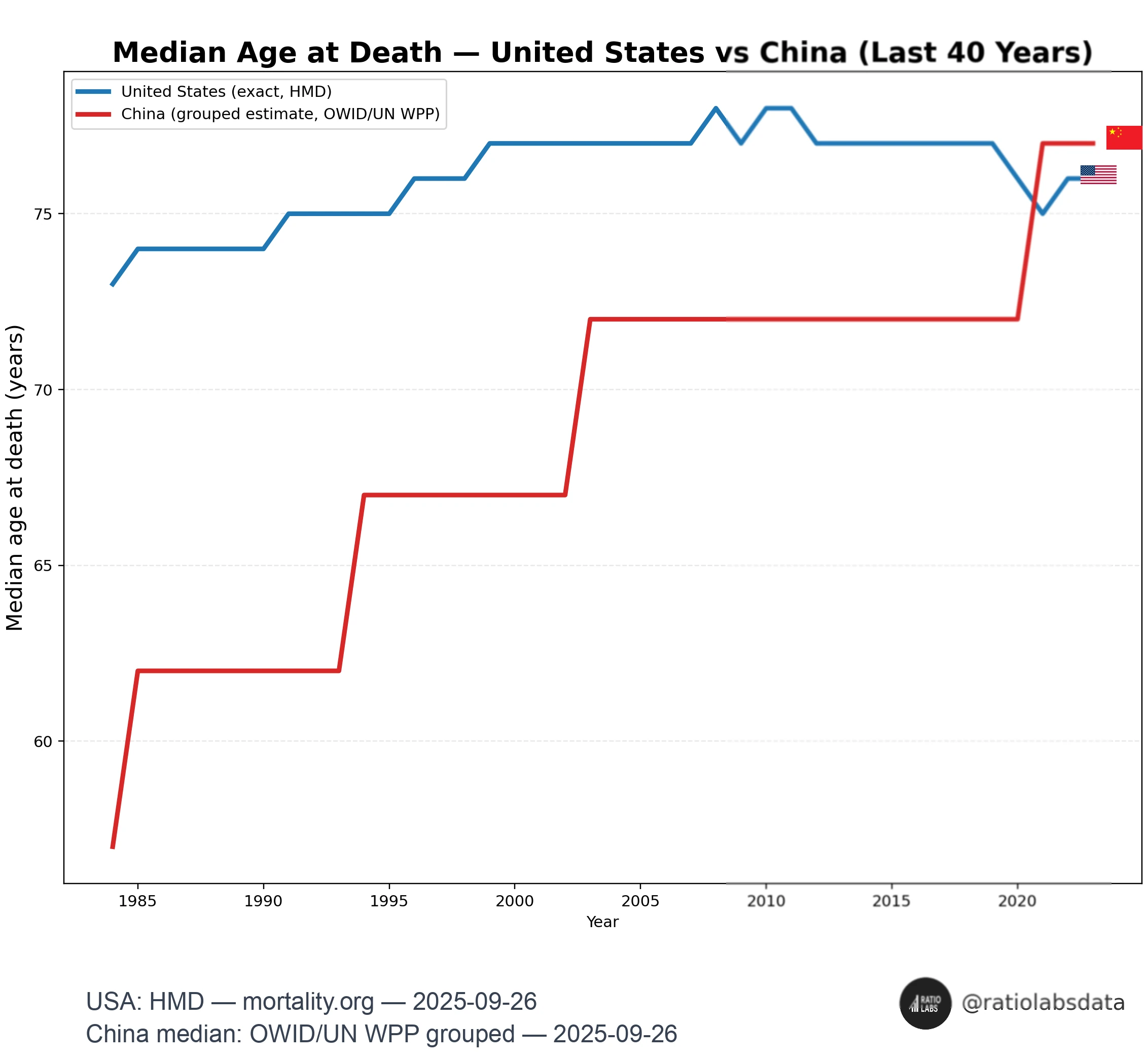
I’ve always believed that the real stories behind the numbers aren’t just in the spreadsheets—they’re in the lives they touch. Take a simple line chart plotting median age at death in the US and China over the past few decades. It’s not flashy, no dramatic spikes or crashes, just two steady climbs that tell a tale of transformation. On one side, the US holds a lead, hovering around 78 or 79 years in recent years, a testament to our advanced healthcare and lifestyle perks. But China? It’s closing in fast, surging from the low 60s in the 1980s to the mid-70s today, with projections whispering that it could match or even edge past us by the 2030s. That’s not just a demographic footnote; it’s a signal flare for anyone in American business eyeing the horizon.
Picture this: a nation of 1.4 billion people, where folks are living longer, healthier lives than ever before. Back in the ’80s, China’s median age at death lagged by nearly two decades, weighed down by the echoes of revolution, famine, and a healthcare system still finding its feet. Fast-forward to now, and you’ve got a powerhouse that’s poured trillions into universal coverage, tech-driven diagnostics, and public health campaigns that make our own feel quaint. It’s the kind of progress that doesn’t happen by accident—it’s fueled by a government laser-focused on stability and growth, turning potential crises into opportunities.
And here’s where it gets exciting for US companies. An aging population isn’t a burden; it’s a blueprint for booming markets. Think about the ripple effects: more retirees means skyrocketing demand for everything from premium pharmaceuticals and telemedicine apps to ergonomic home goods and leisure travel packages. China’s middle class, already massive, is graying with disposable income to burn. I’ve chatted with execs who’ve dipped a toe in—ones who started with market observation teams in Shanghai, crunching data on consumer habits, and ended up scaling full operations in Guangdong. They talk about how the sheer volume of opportunity dwarfs what you’d find stateside. A single pilot study on eldercare tech can uncover needs for adaptive robotics or AI companions that translate directly back to American suburbs.
But it’s not all about the seniors. Longer lifespans mean a more experienced workforce, one that’s sticking around longer and innovating with the wisdom of years. US firms expanding here aren’t just selling products; they’re tapping into collaborative ecosystems where joint ventures blend Silicon Valley speed with Shenzhen’s manufacturing muscle. I remember a buddy at a Midwest med-tech outfit who hesitated on China—too many headlines about trade spats. Then he ran the numbers on that age-at-death gap narrowing, saw the projected 300 million seniors by 2030, and greenlit a observation outpost in Beijing. Six months later, they’re prototyping wearables tailored for urban Chinese lifestyles, with patents pending on both sides of the Pacific.
Of course, jumping in isn’t without its navigation charts. Regulatory mazes, cultural nuances, and yes, those geopolitical headwinds demand smart, patient moves. That’s why starting with boots-on-the-ground observation makes sense—send a small team to embed, observe, and build relationships before committing big. It’s low-risk reconnaissance that pays dividends, whether you’re in healthcare, consumer goods, or even fintech eyeing pension tech.
The chart that sparked this ramble? It’s a humble reminder that demographics don’t lie. While we’re busy debating policy tweaks back home, China’s rewriting its own script, one longer life at a time. For American companies, ignoring it means missing the next great wave. Why watch from the shore when you could be riding it? If you’re on the fence, grab a coffee, pull up that graph yourself, and start sketching out what a foothold in this evolving giant could look like for your bottom line. The future’s aging gracefully—make sure your business does too.
Can you afford not to be in China?
Want to observe the market for new technologies and innovations?
Talk to us, we’ll help you succeed in China.